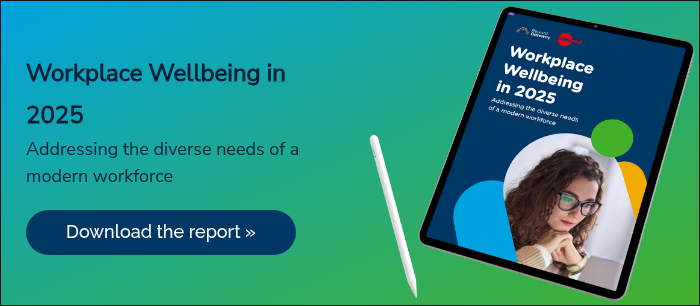It’s no secret that supporting employee wellbeing is critical for organizations that want to create environments where both people and businesses succeed. But don’t just take it from us – 50% of employees rank wellbeing support as more important than a 10% pay raise.
Our latest report, Workplace Wellbeing in 2025: Addressing the diverse needs of a modern workforce, dives deep into what’s working, what isn’t, and what companies can do to support their employees in a rapidly changing world.
Let’s jump right into these five key findings that highlight the urgent need to prioritize employee wellbeing:
1. Stress and burnout are still major issues
Despite increased attention on wellbeing, stress remains a persistent challenge in the workplace. One-third (32%) of employees frequently experience stress, with 25% reporting burnout. And while work can cause stress, the stress of one’s personal life carries over to work as well – nearly half (47%) of employees indicate that the rising cost of living is adding to their stress levels. It’s clear that more needs to be done to address these pressures and provide employees with the support they need to thrive.
2. Managers are key to employee wellbeing
 Most managers (71%) feel responsible for the wellbeing of their teams. This sense of responsibility is valid, as employees consistently say that having a manager who cares about their wellbeing is one of the most important factors in their happiness at work. However, managers are also under pressure and often experience more burnout and stress than non-managers. To support employees effectively, companies must ensure their managers have the tools and resources they need to maintain their own wellbeing, while also fostering an environment where employees feel seen, heard, and supported.
Most managers (71%) feel responsible for the wellbeing of their teams. This sense of responsibility is valid, as employees consistently say that having a manager who cares about their wellbeing is one of the most important factors in their happiness at work. However, managers are also under pressure and often experience more burnout and stress than non-managers. To support employees effectively, companies must ensure their managers have the tools and resources they need to maintain their own wellbeing, while also fostering an environment where employees feel seen, heard, and supported.
3. Employees appreciate existing wellbeing support – but there’s room for improved feedback and recognition
The good news: employees recognize the support they’re receiving. Half of employees say their managers are listening to their concerns (51%), and that they’re receiving good physical wellbeing support at work (49%). However, only a quarter of employees (25%) feel consistently recognized for their hard work, underscoring the need for more frequent feedback and recognition, both of which are key drivers of employee wellbeing.
4. Women and managers are particularly vulnerable to burnout
 Certain groups of employees are disproportionately affected by burnout and stress. Women are more likely to experience burnout than their male counterparts, with 44% of female employees reporting burnout compared to 36% of men.
Certain groups of employees are disproportionately affected by burnout and stress. Women are more likely to experience burnout than their male counterparts, with 44% of female employees reporting burnout compared to 36% of men.
Additionally, managers are at greater risk of burnout, feelings of overwhelm and stress (28%, 29%, 34%) than non-managers (24%, 24%, 29%) due to the added responsibilities of leading teams and meeting business goals. Organizations need to create a support system that specifically addresses the unique challenges faced by these groups.
5. Employees want clear expectations, fair workload distribution and recognition for their work
When asked what would improve their wellbeing, employees expressed a strong desire for clear goals and fair workload distribution. 40% of employees want their managers to provide clear expectations, 36% want to see fair and equitable workloads and 34% want their managers to provide regular feedback and recognition. These insights highlight that while financial compensation is important, employees also want to feel that their work is meaningful, manageable, and recognized.
Moving forward: How to support wellbeing in the workplace
 As we look ahead to 2025, it’s clear that creating a supportive, inclusive, and wellbeing-driven workplace culture is no longer optional – it’s essential for success. By listening to employees, prioritizing wellbeing and creating clear, supportive systems, companies can improve engagement, reduce turnover and set themselves up for long-term success.
As we look ahead to 2025, it’s clear that creating a supportive, inclusive, and wellbeing-driven workplace culture is no longer optional – it’s essential for success. By listening to employees, prioritizing wellbeing and creating clear, supportive systems, companies can improve engagement, reduce turnover and set themselves up for long-term success.
Download the full Workplace Wellbeing in 2025 report today to learn more and start making meaningful changes in your organization!

 Kristin Bassett
Kristin Bassett




